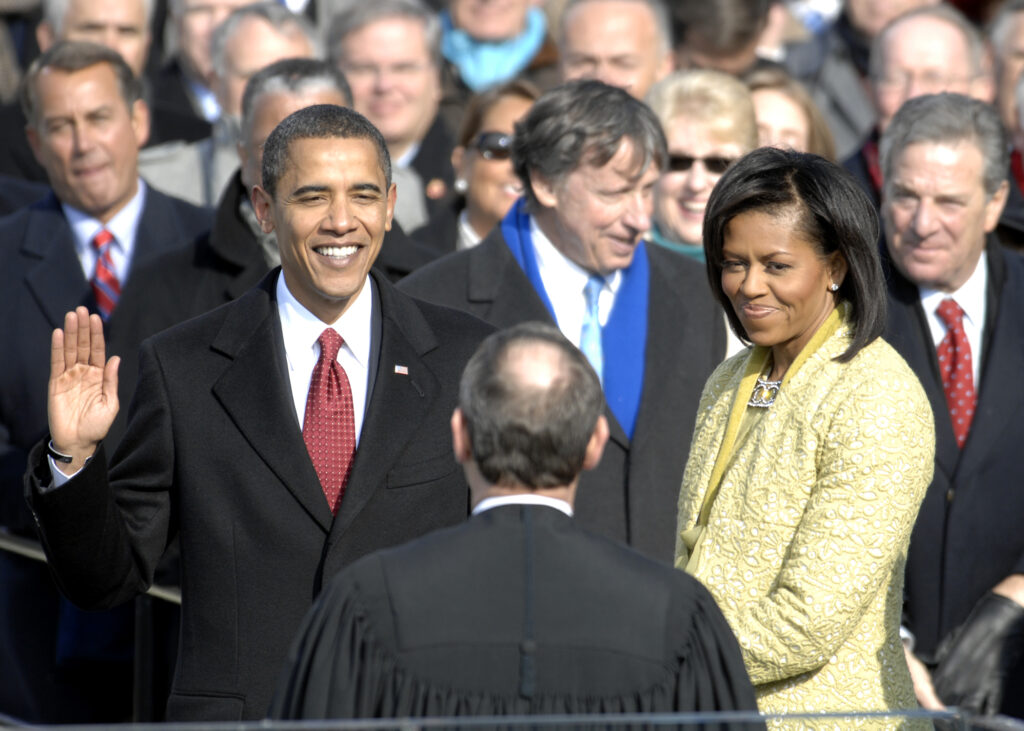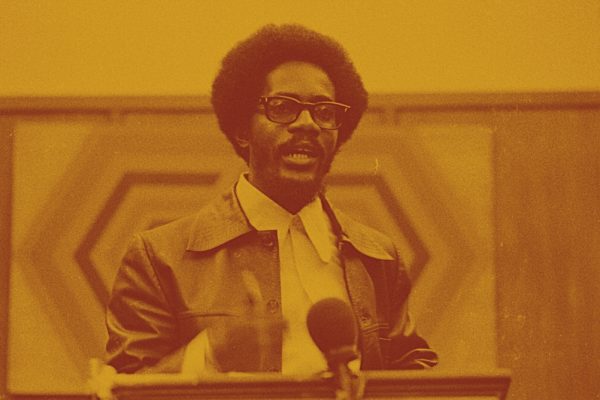Barack Obama’s victory in the 2008 presidential election marked the first time a Democrat won a majority of all votes cast for president since 1964. Political scientists had widely forecast a Democratic victory in 2008 based on the faltering economy and the shift in party identification. But there were reasons to temper confidence in such forecasts. First, similar predictions had failed in 2000, and Obama faced a candidate viewed as far more moderate than he. Second, and most significant, Obama is black. If ever there was a situation where the old politics of race would drag a Democrat down, this was it. Why, then, did Obama win? Closer examination of exit polls points to a surprising conclusion. Obama won because of race—because of his particular appeal among black voters, because of the changing political allegiances of Hispanics, and because he did not provoke a backlash among white voters.
Black and Hispanic voters turned out for Obama in record numbers, and this additional support among nonwhites proved decisive. Obama captured ten million more votes in 2008 than John Kerry did in 2004, resulting in a 4.6 percentage point swing toward the Democrats from 2004 to 2008. This swing did not occur similarly or uniformly among all politically relevant groups, as forecasting models might suggest. Most of the additional Democratic votes were cast by black and Hispanic voters—4.3 million and 2.7 million more, respectively. Democrats also gained among white voters, but the increase was a modest 3 million votes. John McCain, on the other hand, received 2.3 million fewer votes than did George W. Bush in 2004. Most of this loss, 1.5 million votes, came from the net defection of blacks and Hispanics who voted Republican four years earlier; by comparison he lost “only” 1.4 million white voters. Thus, Obama gained not only by bringing new minority voters into the electorate, but also by converting minority voters who had previously been in the GOP stable.
Had Blacks and Hispanics voted Democratic in 2008 at the rates they had in 2004, McCain would have won.
The changes in voting patterns reflect both increased support for Democrats and increased turnout among nonwhite voters. The percentage of blacks voting for the Democratic presidential candidate rose from 88 percent in 2004 to 95 percent in 2008; the percentage of Hispanics voting for the Democrats rose from 56 percent in 2004 to 67 percent in 2008—swings of 7 and 11 percent. White voters, the largest racial group, increased their support of the Democratic candidate by just 2 percentage points, from 41 percent for Kerry to 43 percent for Obama. Changes in turnout further magnified the swing in support. Whites represent a dwindling share of the electorate: 81 percent in 2000, 77 percent in 2004, and 74 percent in 2008. Blacks, by contrast, increased from 10 percent in 2000 to 11 percent in 2004 to 13 percent in 2008; Hispanics increased from 6 percent in 2000 to 8 percent in 2004 to 9 percent in 2008. Of the two effects, increased support of Democrats by nonwhite voters was critical. Had the racial composition of the electorate stayed the same in 2008 as it was in 2004, and had whites remained as supportive of Republicans as they were in 2004, Obama would still have won the popular vote, albeit by a much smaller margin. But, had Blacks and Hispanics voted Democratic in 2008 at the rates they had in 2004 while whites cast 43 percent of their vote for Obama, McCain would have won.
That same story plays out in the battleground states. These states included nine states that switched from Republican to Democratic (Colorado, Florida, Indiana, Iowa, Nevada, New Mexico, North Carolina, Ohio, and Virginia) and three that remained in the GOP camp (Missouri, Montana, and North Dakota). In the battleground states that flipped, the very high Democratic vote share among nonwhite voters or increased turnout among nonwhite voters proved pivotal in Obama’s victory. Some of these states, such as Virginia and Indiana, also saw significant Democratic gains among whites, but Obama did not win majorities of these states’ whites and relied on overwhelming majorities from nonwhites to make up the deficit. The battleground states that Obama did not win are the exceptions that prove the rule. Obama failed to capture Montana and North Dakota because these states lack sizable minority populations, although he did make significant gains among whites. Missouri saw very little change in a highly polarized electorate.
Race was also uniquely important in that no other broad demographic division proved decisive in the 2008 election. The hip, technophilic Obama campaign bet on mobilizing young voters. And those under thirty did vote overwhelmingly Democratic, giving Obama 66 percent of their votes, compared to 54 percent for Kerry, 48 percent for Al Gore, and 53 percent for Bill Clinton’s reelection effort. But their turnout tracked recent elections. Voters under the age of thirty made up 18 percent of the electorate in 2008, compared to 17 percent in 1996, 2000, and 2004, nowhere near the historic highs of 1972 and 1992. Had Obama relied only on a surge among young voters, holding other groups at the 2004 voting behaviors, he would have fallen short of victory.
Obama’s victory, built upon the highest degree of racial polarization seen in many years, has ushered in a period of racial good feelings.
Ironically, the candidate whom commentators lionized for ending America’s debilitating racial divisions won the election on the basis of increasingly distinct white and nonwhite voting patterns. Racial polarization in American voting patterns (the difference between black support for Democrats and white support for Democrats) was the highest it has been since the 1984 election. This resulted not from the increased appeal of Republicans to whites (as in the early 1980s), but to the increased attraction of nonwhites to the Democratic Party.
This is the new politics of race. Its endurance depends on how three political challenges are handled over the next two to four years. First, the Obama administration must maintain its continued appeal to white voters. Although the Democrats made only modest gains with this group, whites still constitute three-fourths of the electorate. During the 1980s, Democrats won, on average, 38 percent of the white vote. If Obama’s support among whites were to sink to that level in 2012, he would almost surely lose. One obvious strategy for the Republican party over the next four years is to bring back the old racial politics and drive a wedge between white voters and the Democratic party.
Second, Obama needs Hispanics. Hispanics voted for Obama by large margins in Colorado, Nevada, New Mexico, and Florida, but that group is not uniquely aligned with him—after all, Hillary Clinton won this segment in the Democratic primary electorate. Without Hispanic support in these states, achieving an electoral vote victory is much more challenging for either party. Obama’s success with this group owes much to the Republicans’ failure to appeal to the typical Hispanic or Latino voter, especially on immigration. And the Republicans are clearly on the wrong side of a relentless demographic march, as younger Hispanic voters are registering Democratic by large margins. That trend even holds in Florida, where the anti-Castro Cuban community has historically dragged Hispanics into the Republican column.
Finally, redistricting is fast approaching following the 2010 census, and the results of the 2008 election will guide that process. The courts, and thus the legislatures, rely on measures of racially polarized voting to determine when and where majority-minority districts—districts in which the majority of the voting-age population is a member of a group in the minority nationally—are justified. The high degree of racial polarization in 2008 will keep the pressure on state legislatures to create as many majority-minority districts as possible, which may cause a deep division between white Democrats and black and Hispanic Democrats in state legislatures and a return to some of the old politics of race within the Democratic party.
However the politics play out over the next four years, the results of the 2008 election challenge much of what has been conventionally thought about race and politics in America. Barack Obama has accomplished an astonishing political move. By disproportionately energizing nonwhite voters and converting erstwhile Republican supporters within the minority community without alienating white voters, he has built the largest Democratic popular vote in a generation. His victory, built upon the highest degree of racial polarization seen in many years, has ushered in a period of racial good feelings.








